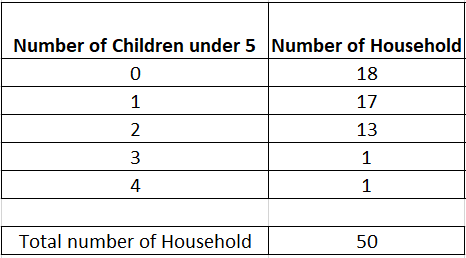To predict future enrollment in a school district, fifty households within the district were sampled, and asked to disclose the number of children under the age of five living in the household. The results of the survey are presented in the table. Complete parts (a) through (e) below. Number of ChildrenNumber of under 5 Households 18 17 2 3 4 13 (a) Construct a relative frequency distribution of the data. Relative Children under 5 Frequency Number of 3 4 (Type integers or decimals. Do not round.) (b) What percentage of households has two children under the age of 5? (Type an integer or a decimal. Do not round.) (e) What percentage of households has one or two children under the age of 5? (Type an integer or a decimal. Do not round.)
To predict future enrollment in a school district, fifty households within the district were sampled, and asked to disclose the number of children under the age of five living in the household. The results of the survey are presented in the table. Complete parts (a) through (e) below. Number of ChildrenNumber of under 5 Households 18 17 2 3 4 13 (a) Construct a relative frequency distribution of the data. Relative Children under 5 Frequency Number of 3 4 (Type integers or decimals. Do not round.) (b) What percentage of households has two children under the age of 5? (Type an integer or a decimal. Do not round.) (e) What percentage of households has one or two children under the age of 5? (Type an integer or a decimal. Do not round.)
MATLAB: An Introduction with Applications
6th Edition
ISBN:9781119256830
Author:Amos Gilat
Publisher:Amos Gilat
Chapter1: Starting With Matlab
Section: Chapter Questions
Problem 1P
Related questions
Question
100%

Transcribed Image Text:To predict future enrlment in a school district, fifty households within the district were sampled, and asked to disclose the number of children under the age of five living in the
household. The results of the survey are presented in the table. Complete parts (a) through (c) below.
Number of ChildrenNumber of
under 5
Households
18
17
13
(a) Construct a relative frequency distribution of the data.
Number of
Relative
Children under 5 Frequency
2
3
(Type integers or decimals. Do not round.)
(b) What percentage of households has two children under the age of 5?
(Type an integer or a decimal. Do not round.)
(c) What percentage of households has one or two children under the age of 5?
(Type an integer or a decimal. Do not round.)
Expert Solution
Step 1
Given,

The basic formula for the relative frequency:
Relative frequency =Frequency of particular children / Total number of frequency
Trending now
This is a popular solution!
Step by step
Solved in 2 steps with 2 images

Knowledge Booster
Learn more about
Need a deep-dive on the concept behind this application? Look no further. Learn more about this topic, statistics and related others by exploring similar questions and additional content below.Recommended textbooks for you

MATLAB: An Introduction with Applications
Statistics
ISBN:
9781119256830
Author:
Amos Gilat
Publisher:
John Wiley & Sons Inc

Probability and Statistics for Engineering and th…
Statistics
ISBN:
9781305251809
Author:
Jay L. Devore
Publisher:
Cengage Learning

Statistics for The Behavioral Sciences (MindTap C…
Statistics
ISBN:
9781305504912
Author:
Frederick J Gravetter, Larry B. Wallnau
Publisher:
Cengage Learning

MATLAB: An Introduction with Applications
Statistics
ISBN:
9781119256830
Author:
Amos Gilat
Publisher:
John Wiley & Sons Inc

Probability and Statistics for Engineering and th…
Statistics
ISBN:
9781305251809
Author:
Jay L. Devore
Publisher:
Cengage Learning

Statistics for The Behavioral Sciences (MindTap C…
Statistics
ISBN:
9781305504912
Author:
Frederick J Gravetter, Larry B. Wallnau
Publisher:
Cengage Learning

Elementary Statistics: Picturing the World (7th E…
Statistics
ISBN:
9780134683416
Author:
Ron Larson, Betsy Farber
Publisher:
PEARSON

The Basic Practice of Statistics
Statistics
ISBN:
9781319042578
Author:
David S. Moore, William I. Notz, Michael A. Fligner
Publisher:
W. H. Freeman

Introduction to the Practice of Statistics
Statistics
ISBN:
9781319013387
Author:
David S. Moore, George P. McCabe, Bruce A. Craig
Publisher:
W. H. Freeman